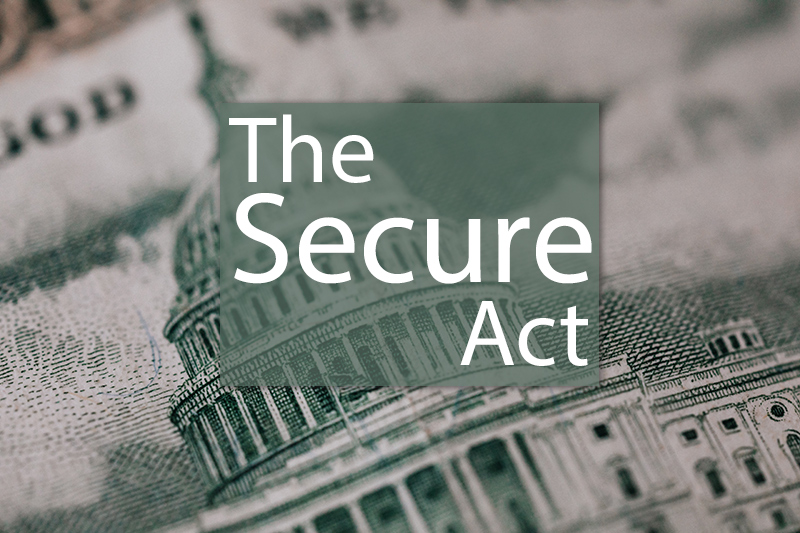Secure Act 2.0: IMPACT ON RETIREMENT PLANS AND HELPING AMERICANS SAVE
The Setting Every Community Up for Retirement Enhancement (SECURE) Act of 2019 was broad legislation aimed at employer-sponsored plans and brought significant change to retirement savings plans.
The SECURE 2.0 Act provisions enacted on December 29, 2022, do even more to help increase the ability of individuals to save for retirement in addition to start-up tax credits for many small businesses to start new retirement plans.
Bulleted below, we look at some of the more impactful provisions of Secure 2.0
- Save more [and longer] toward retirement.
- Increases to the required minimum distribution (RMD) age. The age at which investors must start taking withdrawals from individual retirement accounts (IRAs) is on the rise. The original SECURE Act pushed the RMD age from 70.5 to 72, but SECURE 2.0 Act has raised the age to 73 beginning in 2023. The age will increase again to 75 by 2033.
Note: because the new RMD age of 73 is effective for anyone turning 72 this year, no one will hit their RMD age in 2023.
- Expand Catch-up Contributions. Catch-up contributions are available to individuals 50 or older and provide a way to maximize savings as you near retirement age. The new legislation adds incentives to save even more. For example, while catch-up contributions for IRAs are currently maxed out at $1,000, they will be adjusted for inflation in increments of $100 beginning in 2024.
- In 2025, the catch-up contribution maximums rise for investors between the ages of 60 and 63 in an employer plan. The limits will be increased to 50% more than the regular catch-up limit or $10,000, whichever is greater.
2. Roth Tax Treatment: Roth IRAs, 401(k)s and 403(b)s: The new legislation makes these vehicles even more appealing to investors, with a few key changes.
- Effective immediately, vested employer contributions are now eligible for Roth treatment. Employers may now offer employees the option have employer contributions (both matching and nonelective) made to employees’ Roth accounts in 401(k) and 403(b) plans.
- Effective in 2024, investors with Roth 401(k)s or 403(b)s will no longer be required to take lifetime RMDs from those accounts. Distributions for employer Roth accounts will be more in line with traditional Roth IRAs, which do not require withdrawals until after the death of the account owner.
- Roth treatment required for some catch-up contributions. Starting in 2024, all catch-up contributions to retirement plans will be made on an after-tax basis for individuals who earn $145,000 or more, even if regular contributions are made on a pre-tax basis.
- SIMPLE and SEP Roth IRA options added. Small-business owners now have the option to offer Roth versions of Savings Incentive Match Plan for Employees (SIMPLE) and Simplified Employee Pension (SEP) IRAs, in addition to traditional versions of those plans.
- Significant expansion of startup tax credits for certain costs paid by the employer.
- The small business start-up tax credit has increased to cover 100% (up from 50%) of administrative expenses up to $5,000 for the first three years of a plan established by employers with up to 50 employees beginning in the 2023 tax year.
- Provides a significant additional annual tax credit to small businesses for employer contributions to Defined Contribution plans of up to $1,000 per employee. The credit phases out over five years
with further reductions for employers between 51 and 100 employees.
NOTE: An inactive plan that wants to re-start their plan and is within three years of being established or maintained, may not be eligible for the start-up credit. You should consult a tax advisor.
- For businesses looking to obtain the new plan start-up credit for a SIMPLE IRA plan, the non-highly compensated employee requirements apply. A company will need at least one NHCE to obtain the new plan start credit. Please consult a tax advisor for additional details.
- Automatic Enrollment Requirement
- Requires any 401(k) or 403(b) plan established after December 29, 2022, to automatically enroll eligible employees beginning in the 2025 plan year.
- Beginning in 2025, employers would be required to automatically enroll new employees in the plan at a pretax contribution level of at least 3% of the employee’s pay, but no more than 10%.
- The contribution rate must increase annually by 1% up to at least 10%, but not more than
- 15% of the employee’s pay.
- Employees can opt out or affirmatively elect a different contribution.
- The plan must allow automatically enrolled participants to opt out within 90 days and receive back their contributions.
- Businesses with 10 or fewer employees, new companies in business for less than 3 years, church plans and governmental plans are excluded from this requirement.
- Long-term Part-time Employee Eligibility
- The 2019 SECURE Act expanded eligibility for long-term, part-time workers (those who worked at least 500 hours for three consecutive years) to contribute to their employers’ 401(k) plan.
- SECURE 2.0 Act further expedites their eligibility into the plan by shortening the eligibility period from three years to two years for plan years beginning after December 31, 2024.
- Emergency Savings and Withdrawals
- Beginning in 2024, plan participants will be able to withdraw up to $1,000 per year from their retirement savings account for emergency expenses without having to pay the 10% tax penalty for early withdrawal if they’re underage 59½. In addition, companies could allow employees to set up an emergency savings account through automatic payroll deductions. These contributions would be limited to $2,500 per year.
- Student Loan Matching Contributions
- Beginning in 2024, student loan payments could count as retirement contributions for the purpose of qualifying for matching contributions in a workplace retirement account. In addition, employers will be able to make contributions to their company retirement plan on behalf of employees paying student loans instead of saving for retirement.
- The matching contributions for student loan payments must vest under the same schedule as other matching contributions. Employees must be eligible for a match to receive the student loan matching contribution.
- Allows for beneficial treatment of these contributions for non-discrimination testing.
- Saver’s Match
- Beginning in 2027, low to middle-income employees (those earning up to $71,000 per year) will be eligible for a federal matching contribution of up to $2,000 per year that must be deposited in their retirement savings account. The match phases out based on income and replaces the current Saver’s Credit.
- Tools for Tax-Efficient giving
- 529-to-Roth rollover option. Starting in 2024, 529 education plan assets can be rolled over directly into a Roth IRA for the beneficiary of the 529 plan, within certain limitations. This should allay fears of over-funding a 529 plan or a beneficiary who elects not to use the funds for higher education.
- Expansion of qualified charitable distributions (QCDs). Currently, individuals can make up to $100,000 of QCDs annually, beginning at age 70 ½. Under SECURE 2.0 Act, starting in 2024, the QCD limit will be indexed for inflation, which means it is likely to be substantially more than the current limit.
- What’s not in the Secure 2.0 Act- a quick list of what the act does not change.
- Conversions to a Roth IRA from a traditional IRA or employer-sponsored plan
- Backdoor Roth IRA conversions
- The age at which QCDs are permitted (it remains at 70 ½ or older)
- The types of investments that can be purchased with retirement funds.
- The “10-year rule” for inherited IRAs implemented under the SECURE Act
Ready for a discussion- schedule time
The SECURE 2.0 Act of 2022 brings big changes to retirement plans, and many of these changes are complex and involve long-term planning.
All content is for information purposes only. It is not intended to provide any tax or legal advice or provide the basis for any financial decisions. Nor is it intended to be a projection of current or future performance or indication or future results.
Opinions expressed herein are solely those of Genesis Wealth Management Group, LLC, and our editorial staff. The information contained in this material has been derived from sources believed to be reliable but is not guaranteed as to accuracy and completeness and does not purport to be a complete analysis of the materials discussed. All information and ideas should be discussed in detail with your individual adviser prior to implementation. Advisory services are offered by Genesis Wealth Management Group, LLC an Investment Advisor in the State of Illinois. Being registered as an investment adviser does not imply a certain level of skill or training. Insurance products and services are offered through Genesis Insurance & Financial Advisors, LLC and Genesis Financial Group, Inc., affiliated companies.
The information contained herein should in no way be construed or interpreted as a solicitation to sell or offer to sell advisory services to any residents of any State other than the State of Illinois and Missouri or where otherwise legally permitted.
Images and photographs are included for the sole purpose of visually enhancing the website. None of them are photographs of current or former Clients. They should not be construed as an endorsement or testimonial from any of the persons in the photograph.
Purchases are subject to suitability. This requires a review of an investor’s objective, risk tolerance, and time horizons. Investing always involves risk and possible loss of capital.
Links to Other Sites – The inclusion of any link is not an endorsement of any products or services by Genesis Wealth Management Group, LLC. All links have been provided only as a convenience. These include links to websites operated by other government agencies, nonprofit organizations, and private businesses. When you use one of these links, you are no longer on this site and this Privacy Notice will not apply. When you link to another website, you are subject to the privacy of that new site. When you follow a link to one of these sites neither Genesis Wealth Management Group, LLC, nor any agency, officer, or employee of the Genesis Wealth Management Group, LLC warrants the accuracy, reliability or timeliness of any information published by these external sites, nor endorses any content, viewpoints, products, or services linked from these systems, and cannot be held liable for any losses caused by reliance on the accuracy, reliability or timeliness of their information. Portions of such information may be incorrect or not current. Any person or entity that relies on any information obtained from these systems does so at her or his own risk.





